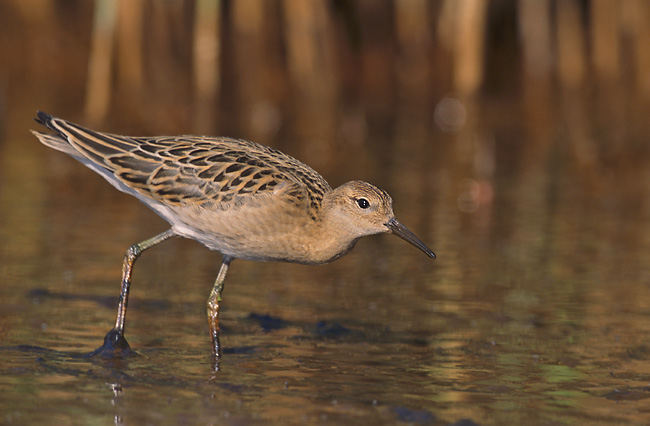|
| Query: philomachus pugnax | Result: 2nd of 21 | |
Ruff (Philomachus pugnax) - Wiki
| Subject: | Ruff (Philomachus pugnax) - Wiki
| |

| Resolution: 650x426
File Size: 93025 Bytes
Date: 2004:11:21 23:58:37
Upload Date: 2007:01:05 23:41:31
|
Ruff
From Wikipedia, the free encyclopedia
[Photo] Ruff, Philomachus pugnax. Author: Marek Szczepanek http://commons.wikimedia.org/wiki/User:Pkuczynski/Marek_Szczepanek
The Ruff (Philomachus pugnax) is a medium-sized wader. It is usually considered the only member of its genus Philomachus, but more recent research (Thomas et al, 2004) indicates that the Broad-billed and Sharp-tailed Sandpiper may belong there too.
Their breeding habitat is bogs, marshes and wet meadows with short vegetation in northern Europe and Russia. Ruff are migratory, wintering in southern and western Europe, Africa and India. They are highly gregarious, with a wintering flock of 1 million birds reported in Senegal.
This species is a rare migrant to North America, but has nested (but is not known to have hatched eggs) in Alaska, USA.
These birds nest in a well-hidden location on the ground, laying 3-4 eggs. The males display at a lek during the breeding season, standing erect, crouching or taking a variety of postures with the ruff erected. They may jump into the air. They are silent while displaying and when not breeding.
These birds forage in wet grassland and soft mud, probing or picking up food by sight. They mainly eat insects and earthworms.
They have a distinctive "gravy boat" appearance, with a small head and medium bill, longish neck and pot-bellied profile. Males are larger than females. They have longish usually yellowish legs, and show white ovals on the tail sides in flight.
Males are 29-32 cm long with a 54-60 cm wingspan. Breeding males grow the most individually distinctive breeding plumages of any wild bird, and recognize each other as individuals by plumage differences. They can have black, chestnut or white "neck ruffs" and "head tufts", made up of solid, barred or irregularly colored feathers (see images below). Their backs are grey-brown and the underparts white except for the black breast.
Females, also called reeves, are 22-26 cm long with a 46-49 cm wingspan. They are grey-brown above and white below. Females nest alone and provide all parental care. In winter, both sexes are a paler grey above and white below and can be differentiated only by size. Young birds have browner more scaly upperparts and are buffy below.
There are two main behavioral types of males (but see end of article), which are fixed by a simple genetic polymorphism: territorial ("resident") and satellite males. These types can be distinguished by their appearance and behaviour: Resident or independent males (84%) have intensely-colored ruffs (black or chestnut) and stake out and occupy small (ca. 1x1 m) mating territories in the lek. They actively court females and display a high degree of aggression towards other resident males.
Satellite males (16%) have light (white or mottled) ruffs and do not occupy own territories, but rather use those occupied by resident males and attempt to mate with females that visit the territory.
The relationship between resident and satellite males can be described as an uneasy alliance, which persists because having both kinds of males on a territory appears to attract additional females to that territory. This encourages partial cooperation between the two males, but they remain competitors to mate with visiting females.
Notably, while satellite males are on average slightly smaller and lighter, the nutrition of the chicks does not influence mating strategy, but rather, the inherited mating strategy heavily influences body size: Resident-type chicks will, if provided with the same amount of food, grow heavier than satellite-type chicks. Therefore, the mating strategies constitute an environmentally stable simple polymorphism.
Moreover, the genetic locus relevant for the mating strategy is located on an autosome. That means that both sexes carry 2 alleles, not only males (whereas mammalian males have the gonosomes XY and females have XX, in birds it is the other way around, males having the gonosomes ZZ and females WZ. W, X, Y and Z are technical terms, with X- and Z-chromosomes or Y- and W-chromosomes being analogous in male- and female-determining heterogame systems, respectively). If ruff females (which are always non-territorial) are given testosterone implants, they display the male territorial behaviour according to their genotype.
In 2006, a third type of male was described: permanent female mimics, the first such reported for birds. About 1 in 100 males are small, intermediate in size between males and females, and do not grow the elaborate breeding plumages of territorial and satellite males. These "female mimics" apparently obtain access to mating territories together with females, and then "steal" matings when females crouch to solicit matings.
The Ruff is one of the species to which the Agreement on the Conservation of African-Eurasian Migratory Waterbirds (AEWA) applies.
http://en.wikipedia.org/wiki/Ruff
| The text in this page is based on the copyrighted Wikipedia article shown in above URL. It is used under the GNU Free Documentation License. You may redistribute it, verbatim or modified, providing that you comply with the terms of the GFDL. |
|
Comments |
|---|
| | Guest |
|
Scientific Name: Calidris pugnax (Linnaeus, 1758)
Common Names:
English – Ruff
French – Chevalier combattant
Synonyms: Philomachus pugnax (Linnaeus, 1758)
Taxonomic Notes: Calidris pugnax (del Hoyo and Collar 2014) was previously placed in the genus Philomachus. |
^o^
Animal Pictures Archive for smart phones
^o^
|
|
|

